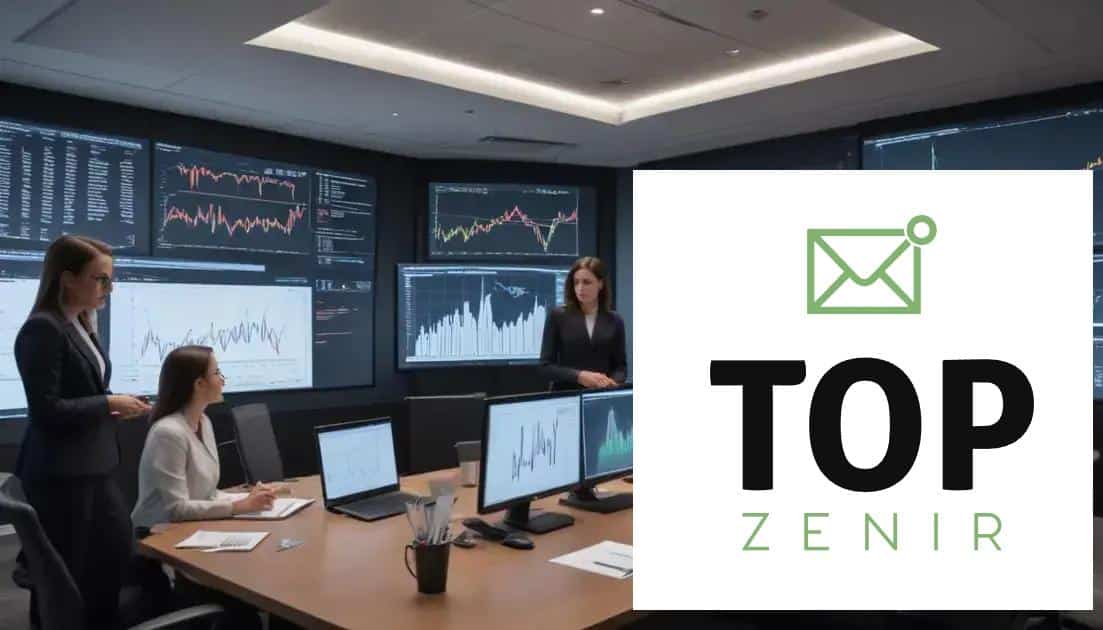Best practices for monitoring corporate credit risks

Best practices for monitoring corporate credit risks involve using early warning systems, monitoring key indicators, and developing responsive action plans to proactively manage potential financial challenges.
Best practices for monitoring corporate credit risks are crucial for businesses aiming to stay financially healthy. Have you ever wondered how your company can detect potential credit issues before they escalate? In this article, we’ll explore essential strategies to enhance your credit risk monitoring.
Understanding corporate credit risks
Understanding corporate credit risks is essential for any business. These risks can lead to significant financial impacts if not managed properly. Companies need to recognize what credit risks are and how they can affect their operations.
What Are Corporate Credit Risks?
Corporate credit risks refer to the possibility that a company will fail to meet its debt obligations. Factors such as economic downturns and poor management decisions can increase these risks. Identifying these risks early is crucial to maintaining financial health.
Key Factors Contributing to Credit Risks
Several elements contribute to corporate credit risks. Knowing these factors can help organizations mitigate potential problems.
- Financial stability: A business’s financial statements reveal its overall health.
- Market conditions: Economic trends impact customer behavior and sales.
- Management decisions: Poor decision-making can lead to significant losses.
Companies should monitor these areas closely.
Additionally, understanding industry-specific risks is vital. Different sectors may experience unique challenges that impact creditworthiness. For example, technology firms face rapid changes in innovation, while manufacturing companies may deal with supply chain issues.
Impact of Credit Risks on Businesses
The impact of credit risks can be severe. Companies with high credit risks might struggle to secure loans. This can limit their growth opportunities and operational flexibility. Moreover, a poor credit rating can harm a company’s reputation, making it harder to attract investors and customers.
To successfully navigate credit risks, businesses need strategies that enable them to perform thorough assessments and implement effective monitoring systems. By addressing these potential issues head-on, organizations can safeguard their financial future.
Key indicators to monitor

Monitoring credit risks effectively requires understanding key indicators. Knowing what to look for helps businesses stay ahead of potential problems. By tracking these indicators, companies can make informed decisions.
Financial Ratios
Financial ratios are important tools for evaluating a company’s creditworthiness. They give insight into financial health and performance. Here are some crucial ratios to keep in mind:
- Debt-to-Equity Ratio: This shows how much debt a company is using to finance its assets.
- Current Ratio: It measures a company’s ability to pay short-term liabilities.
- Interest Coverage Ratio: This indicates how easily a company can pay interest on outstanding debt.
These ratios provide valuable information about a company’s leverage and risk.
Payment History
A company’s payment history is a strong indicator of its credit risk. Late payments or defaults can signal underlying financial issues. Regularly reviewing payment patterns helps businesses identify trends that require attention.
Another important factor is customer payment behavior. Understanding how clients fulfill their financial commitments can lead to better risk assessments. If customers consistently delay payments, it may affect a company’s cash flow and overall health.
Economic Conditions
External factors also play a role in credit risks. Economic downturns, changes in market demand, and political instability can impact a company’s performance. Staying informed about economic indicators such as interest rates, inflation, and GDP growth allows businesses to adjust their strategies accordingly. This proactive approach helps mitigate financial risks.
By paying attention to these key indicators, businesses can better prepare for potential challenges. Monitoring financial ratios, payment history, and economic conditions leads to more effective risk management. Companies can make updates to their strategies and safeguard their financial health by staying ahead of these indicators.
Tools for effective credit risk management
Tools for effective credit risk management are essential for identifying, measuring, and mitigating potential risks. Utilizing the right resources can significantly enhance a company’s ability to maintain financial stability.
Credit Risk Assessment Software
One of the best ways to manage credit risks is by using assessment software. These tools help evaluate a company’s creditworthiness by analyzing various data points. Features often include:
- Automated credit scoring: This provides quick access to credit information.
- Risk modeling: It allows businesses to simulate different scenarios and their potential impact.
- Reporting tools: These can generate detailed reports for stakeholders.
By integrating this software into financial processes, companies can improve decision-making and risk assessments.
Monitoring Platforms
Monitoring platforms are another crucial tool in credit risk management. They provide ongoing insights into credit performance. Using these platforms enables businesses to track key indicators like payment patterns and financial ratios. This real-time data helps in making prompt adjustments. Additionally, many of these platforms offer alert systems that notify users about significant changes.
Another important aspect is the analytics capabilities of these platforms. Advanced analytics can reveal trends that may not be obvious at first glance. Understanding these trends allows companies to anticipate potential issues before they escalate.
Collaboration and Communication Tools
Effective communication is vital when managing credit risk. Utilizing collaboration tools facilitates information sharing among teams. This ensures that everyone is on the same page regarding risk exposure and strategies. By using shared platforms for documentation and updates, businesses can streamline their workflows.
Moreover, implementing a system for regular feedback and discussions helps teams address concerns quickly. Continuous communication can strengthen risk management efforts, making it easier to adapt to changing conditions.
By combining these tools, businesses can create a comprehensive approach to credit risk management. Assessments, monitoring, and effective communication all play significant roles in protecting a company’s financial health.
Implementing early warning systems

Implementing early warning systems is vital for managing corporate credit risks effectively. These systems help identify potential issues before they become significant problems. By using these systems, companies can take proactive steps to safeguard their financial health.
Components of an Early Warning System
Several key components make up an effective early warning system. These include data collection, analysis, and reporting. Each component plays a crucial role in ensuring that businesses can react promptly to emerging risks. Important elements to consider are:
- Data sources: Utilize multiple sources of data, including financial reports, market trends, and credit scores.
- Analytical tools: Implement tools that utilize predictive analytics to identify patterns and forecast risks.
- Alert mechanisms: Set up systems to notify stakeholders when certain thresholds are met or risk indicators are triggered.
Using these components, businesses can create a robust system to monitor credit risks.
Establishing Risk Thresholds
Setting clear risk thresholds is another essential step. These thresholds act as guidelines for when to take action. When certain metrics cross these lines, it signals alertness. This way, companies can respond before issues escalate. Common metrics for establishing thresholds include:
- Liquidity ratios: Monitoring changes in cash flow can indicate potential cash shortages.
- Debt levels: High debt levels relative to income can signal a need for intervention.
- Payment delays: Frequent delays in accounts receivable may indicate risk from customers.
Establishing these thresholds can help companies maintain a strong financial position.
The integration of a comprehensive early warning system allows businesses to stay ahead of risks. By closely monitoring credit performance and adjusting strategies as needed, organizations can effectively mitigate potential threats. Additionally, training staff to recognize early warning signals can enhance the effectiveness of the system.
Investing in early warning systems not only protects companies from financial difficulties but fosters a culture of proactive risk management. This culture encourages continuous improvement and adaptability in response to changing market conditions.
Creating a responsive action plan
Creating a responsive action plan is essential for managing corporate credit risks. When challenges arise, having a clear plan helps ensure that your organization can react swiftly and efficiently. A well-structured action plan includes specific steps to take when certain risk thresholds are met, allowing for timely interventions.
Key Steps in Developing an Action Plan
To build an effective action plan, companies should follow several key steps. Each step serves to clarify the process and empower teams to act appropriately when issues emerge. Important steps to consider include:
- Identify potential risks: Recognize and categorize the credit risks your company might face. This helps prioritize actions.
- Establish response strategies: Determine the steps to take when certain risks materialize. Having predefined strategies reduces confusion during critical moments.
- Assign responsibilities: Clearly outline who is responsible for each aspect of the action plan. This ensures that every team member knows their role.
By following these steps, businesses can position themselves to navigate challenges more effectively.
Monitoring and Adjusting the Plan
A successful action plan is not static. Companies must continuously monitor their exposure to credit risks and adjust their plans accordingly. Regular reviews of the plan help identify areas that need improvement. Incorporating feedback from team members also enhances the plan’s effectiveness.
Another key aspect of a responsive action plan is effective communication. Keeping all stakeholders informed helps align efforts and creates a unified approach to risk management. Regular updates, both formally and informally, can reinforce awareness of potential risks.
In addition, testing the action plan through simulations or drills can prepare teams for real-life scenarios. These exercises can reveal any weaknesses in the plan and highlight areas for refinement. As conditions change, businesses must be agile and ready to adapt their strategies promptly.
By creating and regularly updating a responsive action plan, organizations can protect their financial interests. This proactive approach helps create a culture of resilience, empowering teams to address credit risks as they arise.
In conclusion, managing corporate credit risks requires a comprehensive approach. By implementing effective strategies such as early warning systems and responsive action plans, organizations can safeguard their financial stability. Monitoring key indicators and using the right tools are essential for making informed decisions. With a proactive mindset, businesses can navigate challenges and adapt to changing conditions effectively. This not only protects their interests but also fosters resilience in the face of potential risks.
FAQ – Frequently Asked Questions About Corporate Credit Risk Management
What are corporate credit risks?
Corporate credit risks are the potential that a company will fail to meet its debt obligations, affecting its financial stability.
How can early warning systems help in managing credit risks?
Early warning systems identify potential credit issues before they escalate, allowing companies to take proactive measures.
What key indicators should be monitored for credit risk management?
Key indicators include financial ratios, payment history, and external economic conditions that affect creditworthiness.
Why is having a responsive action plan important?
A responsive action plan ensures that companies can quickly address emerging risks and maintain financial stability.





